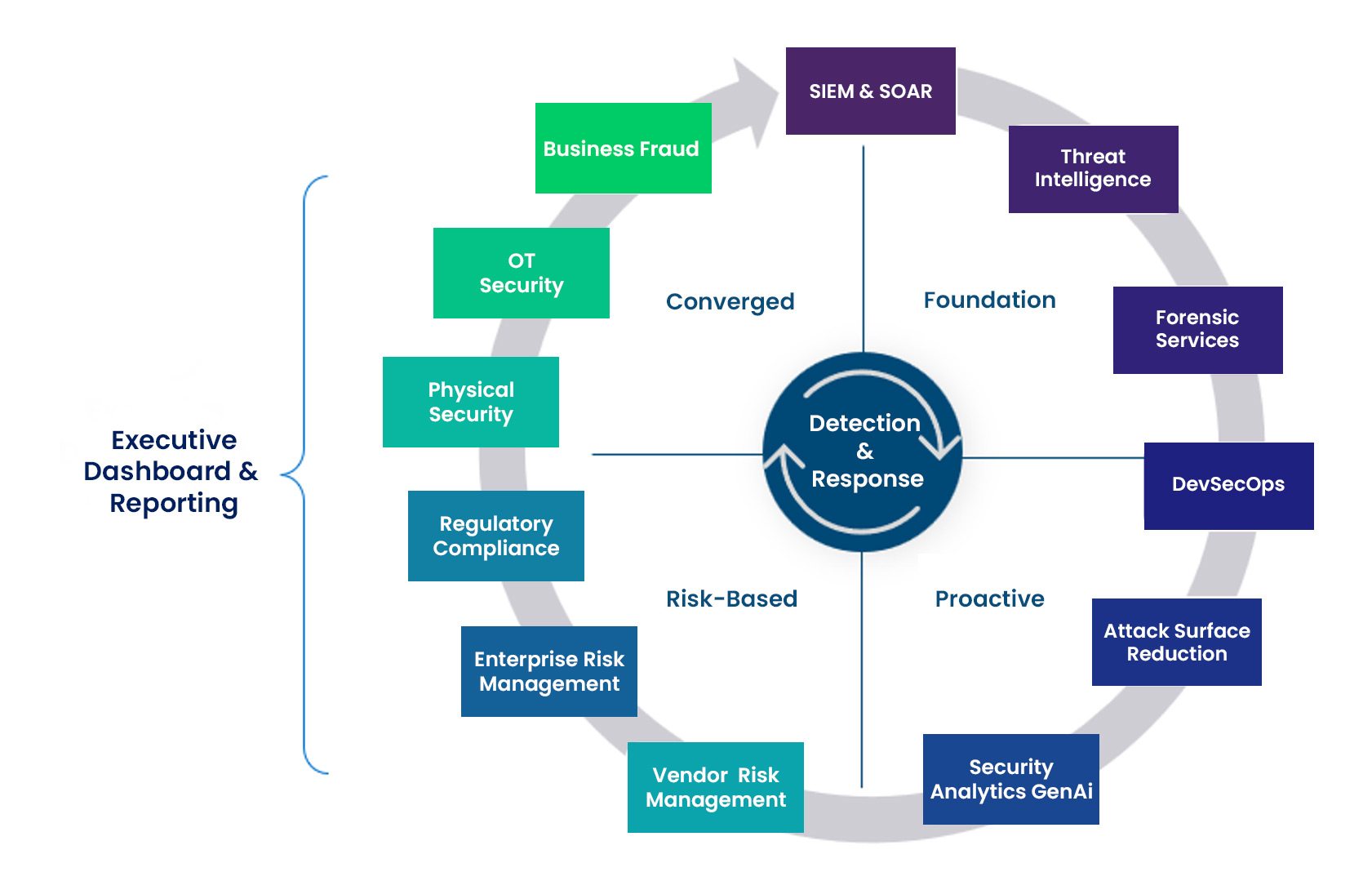Fortifying Healthcare: Cybersecurity Fusion Centers (CFC) to Battle Evolving Cyber Threats
December 4, 2023
In a world increasingly connected by technology, the healthcare sector finds itself under siege from an array of relentless cyber threats. Patient records, research data, and vital healthcare infrastructure have all become enticing targets for cybercriminals seeking to exploit vulnerabilities and compromise the integrity of healthcare systems. Even as healthcare organizations continue to adopt the latest security solutions to keep pace with the influx of new cyber threats, healthcare data breaches are continuing to impact the sector at alarming rates.
According to the HHS Office for Civil Rights (OCR) data breach portal, the healthcare sector suffered approximately 295 breaches in the first half of 2023 and more than 39 million individuals were implicated in data breaches. Furthermore, the biggest breach of health data in 2023 caused more than 8.8 million Americans to be affected, according to HHS.
For over two decades, Innova Solutions has been a driving force in enhancing organizational cybersecurity. Central to our cybersecurity initiatives is the strengthening of healthcare provider security through our robust Vulnerability Remediation Program. This program, identified as a foundational aspect of Cyber Fusion Centers (CFCs), takes a preventive stance by identifying and addressing vulnerabilities to prevent potential breaches. Delve into our blog, specifically covering the Vulnerability Remediation Program.
While the Vulnerability Remediation Program represents a preventative approach, our commitment extends to the dynamic threat landscape faced by the healthcare sector. In response to relentless cyber threats, an imperative shift toward a proactive and collaborative approach is necessary. This is where CFCs play a crucial role. With a rich history of evolution and adaptability to the evolving cyber threat landscape, CFCs stand as a formidable defense against cyber threats in the healthcare sector.
What is a Cyber Fusion Center (CFC)? Its Evolution Over Time
In the ever-evolving world of cybersecurity, staying ahead of threats has become a relentless pursuit for organizations across all segments. As the threat landscape has transformed over the years, so have the institutions and strategies dedicated to combating cyber threats. Among these transformative entities are Cybersecurity Fusion Centers (CFCs), which have emerged as pivotal players in the ongoing battle against cyber adversaries. Initially, Security Operations Centers (SOCs) were the norm, but CFCs represent the next phase in the industry’s cybersecurity evolution.
The early 2000s marked a turning point in the history of cybersecurity. In the wake of the devastating 9/11 attacks, the United States realized the need for a more unified and proactive approach to security. Thus, CFCs were born, initially under the umbrella of the U.S. Department of Homeland Security. The primary aim was to eliminate the siloed operations that had hampered effective threat response in the past.
During their early years, CFCs focused predominantly on physical threats and acts of terrorism. These centers brought together intelligence from diverse sources, fostering collaboration among government agencies, private-sector entities, and law enforcement.
As the digital realm continued to expand, so did the threats that lurked within it. The 2010s saw a significant shift in the role of CFCs. Large financial organizations and service providers recognized the importance of proactive cybersecurity measures. CFCs adapted by integrating various components of cybersecurity solutions, including advanced technologies like machine learning and artificial intelligence.
Today we see ransomware emerging as a formidable foe and CFCs need to step up the game by embracing automation in tandem with GenAI to detect and respond to threats in real-time.
The Future of CFCs: A Global Expansion and Revenue Generation
Looking ahead, CFCs are poised to expand their horizons even further. Beyond financial organizations and service providers, other industries globally are recognizing the value of the CFC model. Their goals extend beyond cybersecurity; they aim to generate revenue and build customer trust. This shift will not only protect critical infrastructure and businesses but also foster economic growth and resilience in an increasingly digital world.
Cybersecurity Fusion Centers for Healthcare Providers
In addition to financial organizations and service providers, CFCs are a forward-looking concept for healthcare that incorporates elements of a traditional Security Operations Center (SOC) with advanced threat intelligence and collaboration. Here are several reasons why CFCs are considered the future of healthcare cybersecurity:
- Complex Threat Landscape: Healthcare organizations store vast amounts of sensitive patient data, making them attractive targets for cybercriminals. The evolving threat landscape in the healthcare sector demands a proactive and collaborative approach to security.
- Real-time Threat Detection: CFCs use advanced technology, including machine learning and AI, to detect threats in real-time. This enables healthcare providers to respond swiftly to potential breaches and minimize damage.
- Intelligence Sharing: CFCs can collect and share threat intelligence with other healthcare organizations. This collaborative approach ensures that threat information is disseminated quickly, allowing all participants to bolster their security posture.
- Compliance and Regulation: Healthcare is subject to stringent data protection regulations like HIPAA (Health Insurance Portability and Accountability Act) in the United States. CFCs can help organizations stay compliant and avoid penalties by providing tools and insights to strengthen security.
- Rapid Incident Response: In the event of a breach, a CFC can coordinate an effective response by leveraging the combined expertise of various stakeholders. This can include not only the affected healthcare organization but also law enforcement agencies, incident response teams, and third-party security providers.
- Cost Efficiency: Collaborative security models like CFCs can be cost-effective because healthcare organizations can pool resources and share the financial burden of advanced security technologies and expertise.
- Advanced Analytics: CFCs often incorporate advanced analytics and machine learning to predict and prevent cyber threats before they materialize. These capabilities are crucial in a field where even minor security lapses can have life-threatening consequences.
- Continuous Improvement: CFCs can continuously analyze and adapt to new threats and vulnerabilities. This adaptability is essential as cyber threats are constantly evolving.
An effective building block of the Cybersecurity Fusion Center must address the following questions that can help improve the overall risk posture of the organization:
Key components of the CFC
At Innova Solutions, we’ve developed a comprehensive CFC framework that places detection and response at its core, supported by key capabilities serving as foundational pillars to establish a robust CFC:
- Foundational Elements: Utilizing SIEM & SOAR, Threat intelligence, and Forensic services to address security threats in near real-time.
- Proactive Measures: Implementing DevSecOps, Attack Surface Reduction, and leveraging Security Analytics (GenAI) to proactively manage security threats.
- Risk-oriented Approach: Managing vendor risk, Enterprise risk, and Regulatory compliance to achieve centralized visibility into supply chain risks and regulatory compliance risks.
- Convergence Strategy: Integrating physical security, OT security, and Business fraud for centralized visibility into threats and risks related to IT, OT, and business operations around the clock.
Our framework is designed to address a spectrum of security challenges, ensuring a proactive, integrated, and risk-aware approach to safeguarding operations.
Strategic Approach for Cyber Fusion Center Development
At Innova Solutions, we recognize the significant investments global enterprises have made to fortify their cybersecurity stance. Consequently, we have structured a phased approach to construct a Cyber Fusion Center (CFC) as outlined below:
This phased approach ensures a structured and comprehensive methodology for building the Cyber Fusion Center, aligning it with business objectives while optimizing existing investments and fostering innovative solutions.
Navigating the Future with ‘Talk to the Logs’ in Healthcare Cybersecurity Fusion Centers
As we navigate the complex and evolving landscape of healthcare cybersecurity, Innova Solutions’ Cybersecurity Fusion Center, coupled with the guiding principle of “Talk to the Logs,” stands as a beacon of proactive defense. This approach, rooted in collaboration, innovation, and a comprehensive understanding of log data, not only safeguards against cyber threats but charts a course for a resilient and secure healthcare ecosystem. In an era where digital risks are ever-present, the fusion of technology, intelligence, and a cooperative mindset positions us at the forefront of fortifying healthcare against the challenges of tomorrow.
Key Contributor: Divya Gupta – Content/ Research & Sales Enablement







